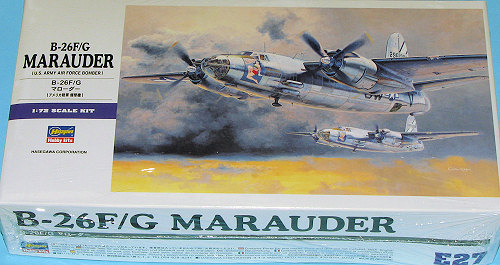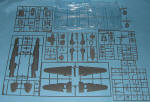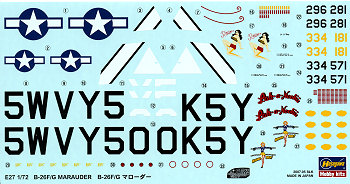
| KIT: | Hasegawa 1/72 B-26F/G Marauder |
| KIT #: | 00557 |
| PRICE: | $ |
| DECALS: | Three |
| REVIEWER: | Scott Van Aken |
| NOTES: |

| HISTORY |
In 1939, the United States Army Air Corps issued a specification for a twin-engined medium bomber, Circular Proposal 39-640. Six months later, Glenn L. Martin Company presented a design to the Air Corps. Peyton M. Magruder led the design team for this aircraft after Martin won the contract. This design, Martin Model 179, was accepted for production before a prototype even flew, due to the desperate need for medium bombers following the intensification of the war in Europe.
Once the first aircraft came off the production line in November 1940, Martin conducted tests, the results of which were promising. The first B-26 with Martin test pilot William K. "Ken" Ebel at the controls, flew on 25 November 1940 and was effectively the prototype. Soon after, it was turned over to the Army Air Corps to be service tested. It went from paper concept to working plane in less than two years.
While the B-26 was a fast plane with better performance than the contemporary B-25 Mitchell, its relatively small wing area and resulting high wing loading (the highest of any aircraft used at that time) led to tricky high-speed landings (approach at 140 mph (225 km/h) and stall at 130 mph (210 km/h) indicated airspeed). The R-2800 engines were reliable, but the electric pitch change mechanism in the propellers required impeccable maintenance and was prone to failure. Failure of the mechanism placed the propeller blades in flat pitch with instant total loss of power. Due to the rotund fuselage, the B-26 engines were placed far outboard, and loss of power on one side resulted in a violent snap roll flipping the aircraft on its back. This led to a high number of accidents during takeoff, thus earning B-26 the nickname "Widowmaker" by its pilots. Other colorful nicknames included "Martin Murderer," "The Flying Coffin," "B-Dash-Crash," "The Flying Prostitute" (because it had no visible means of support, referring to the small wings), and "The Baltimore Whore" (because the Martin Company was located there) (Higham 1975).
The toll eventually led to a halt in production. During this time a commission of inquiry (led by then-Senator Harry Truman) was appointed to look into the problem. When Truman and the other commission members arrived at the Avon Park Bombing Range, they were greeted by the still-burning wreckage of two crashed Marauders. Indeed, the regularity of crashes by pilots training at MacDill Field — up to fifteen in one thirty day period — led to the only mildly exaggerated catchphrase, "One a day in Tampa Bay."
The resulting aircraft (designated B-26B) had a 6 ft (1.8 m) increase in wingspan, and other changes, some of which reduced the aircraft's speed. The newer version had reduced landing and stall speeds. The safety of the B-26B was an immense improvement: it had the lowest attrition rate of any aircraft used during the war. Nevertheless, it remained a challenging plane to fly and continued to be unpopular with potential crews throughout its life.
B-26 crews began flying combat missions in the South Pacific in spring 1942, but most of the aircraft were sent to England and the Mediterranean. The 22nd Army Air Force Bomb Group was originally based in northern Australia to protect the aircraft from Japanese fighter attack but often staged its flights out of Port Moresby, New Guinea. On 9 June 1942, Lt. Cmdr. Lyndon B. Johnson flew on a bombing mission departing for Lae, New Guinea. Johnson's B-26 developed engine trouble and was forced to return to base.
Like the B-25, the B-26 had been designed for medium-altitude bombing, but the war brought medium bombers down to treetop level, and later versions of the B-26 were equipped with a side-mounted battery of forward-firing machine guns for strafing ground targets. The low-level bombing of Utah Beach by the Marauders during the Normandy Invasion contributed to the low casualties among the American assault force.
The B-26 was phased out of Army Air Force service before the end of the war. Their last mission was flown in May 1945.
According to an article in an edition of AOPA Pilot on Kermit Weeks's "Fantasy of Flight", the Marauder had a tendency to "hunt" in yaw. This instability is similar to "Dutch roll". This would make for a very uncomfortable ride, especially for the tail gunner.
| THE KIT |
 I'm
going to start this description by stating that I was not able to find any
sprues that were listed specifically for the F/G variant. What's more, I've not
bought or seen the earlier B-26B kit so cannot comment on whether or not the
fuselage is different between the two to take into account the difference in
wing incidence angle. I've been told that his has been. Looking at the parts
diagram in the instructions, it seems that there are only a few small parts not
used in this kit. I do note that there is no D, H, or I sprue with this one.
Perhaps those are the ones that are different. Another note is that there are
two sprues like the one with the prop blade. I only used one in the photo.
I'm
going to start this description by stating that I was not able to find any
sprues that were listed specifically for the F/G variant. What's more, I've not
bought or seen the earlier B-26B kit so cannot comment on whether or not the
fuselage is different between the two to take into account the difference in
wing incidence angle. I've been told that his has been. Looking at the parts
diagram in the instructions, it seems that there are only a few small parts not
used in this kit. I do note that there is no D, H, or I sprue with this one.
Perhaps those are the ones that are different. Another note is that there are
two sprues like the one with the prop blade. I only used one in the photo.
Anyway, the kit is very nicely molded and I noticed no molding flaws in my inspection of the kit parts. It very much looks like Hasegawa has decided to continue the detail level of their superb B-25s by offering full cockpits, full bomb bay and detailed gunner's positions. In fact, the horizontal stabilizer assembly is in clear plastic as there are two small windows on the upper portion of it for the rear gunner. Even the rear gunner station is nicely done for this scale. The landing gear are rather complex and though it looks fragile, it should hold up well. The bomb bay provides a full load of four 500 lb bombs and one has the option of having the bay doors open or closed. Of course, closing them allows one to be lazy and not install the bombs.
The upper turret is a mini-model in itself and looks
quite complex. This kit includes side gun packs which may not have been part of
the B kit. I found it odd that the two props have separate hubs. There are a
considerable number of small windows in the Marauder and those are so designed
to allow external application, a real plus for most of us. I should also point
out the the instructions have one open the hole in the nose transparency for the
nose gun, yet the description above indicates that this gun
 was deleted on the F model. I can
attest that this aircraft is a major tail-sitter, thanks to the forward raked
main gear as much as anything. Finding room for nose weight seems pretty well
impossible as it will take a considerable amount. A tail stand is provided
was deleted on the F model. I can
attest that this aircraft is a major tail-sitter, thanks to the forward raked
main gear as much as anything. Finding room for nose weight seems pretty well
impossible as it will take a considerable amount. A tail stand is provided
Instructions are the usual for Hasegawa and superbly done with Gunze paint references. There are markings for three aircraft. First is the box art plane from the 587th BS/394th BG in 1944. This unpainted metal plane has a nice nose art. The builder will have to paint the medium blue background. Next is a 459th BS/344th BG aircraft with the upper surfaces painted in Olive Drab. Finally, another plane from the 394th BG, though this one from the 584th BS. Again the OD background to the nose art will need to be painted. Decals are the new type with white white and a properly non-bright reds. Should work fine with setting solutions. I anticipate there being many aftermarket sheets for these planes in the near future.
| CONCLUSIONS |
So there you have it. Hasegawa continues its release of WWII twins with this second and probably final variant of the B-26. As much as I'd like to see a B-26A and early B done, I doubt if the money managers at Hasegawa will spring for the new wing, tailplanes, engine cowlings, rear gunner's position needed to do them, no matter how much I want to model a Silver Fleet aircraft. However, this one is really a beauty and though the B-26 doesn't seem to have the following of the B-25 or A-20, this is a super kit and one that I know will build into a beauty of a model.
| REFERENCES |
http://en.wikipedia.org
July 2007.
My thanks to www.dragonmodelsusa.com
for the review copy. You can get yours from your local hobby dealer or direct
from the link above.
If you would like your product reviewed fairly and quickly by a
site that has nearly 400,000 visitors a month, please
contact
me or see other details in the
Note to
Contributors.